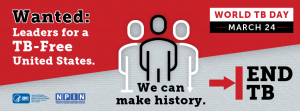Although Tuberculosis (TB) is preventable and curable, many people in the United States still suffer from the disease. Anyone can get TB, and our current efforts to find and treat latent TB infection and TB disease are not sufficient. Misdiagnosis of TB still exists, and health care professionals often do not “think TB,” according to the Centers for Disease Control and Prevention.
In 2017, South Health District had four cases of newly diagnosed TB throughout ten counties compared to the State of Georgia having 293 newly diagnosed cases. That number dropped from 2016 with seven cases in our District and 301 in Georgia.
“In 2016, 48% of reported Tuberculosis cases in Georgia were born outside of the United States,” said Teresa Hritz, RN, infectious disease coordinator. “Since TB rates have declined, not much attention is placed on the disease. I believe this gives the public a false sense of security as they no longer feel TB is a threat.”
TB bacteria are spread through the air from person to person. When a person with TB disease of the lungs or throat coughs, speaks or sings, the bacteria is put into the air. People nearby may breathe in these bacteria and become infected. The bacteria can settle in the lungs and begin to grow. Those infected are most likely to spread the disease to people they spend time with daily: family members, friends, coworkers or classmates.
“We know that Tuberculosis is not the first thought that crosses many physicians’ minds based on some of our local cases,” says Hritz. “Normally the patient is treated for bronchitis with rounds of antibiotics before he or she is sent for the chest x-ray that reveals TB. We want to encourage physicians to think TB when a patient presents with signs and symptoms of Tuberculosis, such as a bad cough for three weeks or more.”
Treatment is key. Without treatment latent TB infection (TB bacteria living in your body without making you sick) can progress to TB disease. If TB disease is not treat properly, it can be fatal. “It is very important for a person infected with the disease to be treated, finish the medicine, and take the drugs exactly as prescribed,” says Hritz. “Through our TB Program, we have case managers that perform direct observation therapy with our patients to ensure they get it correct each time.”
Anyone that believes they have been exposed to Tuberculosis or have the disease, should contact their local health department or health care provider. TB disease can be treated for 6 to 9 months, so the earlier you can start the medications, the better.
For more information, visit www.cdc.gov/tb or call your local health department.

